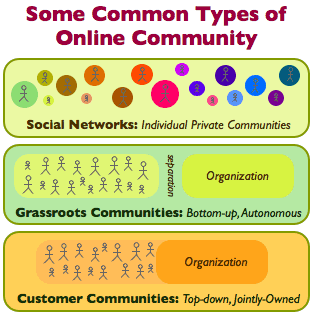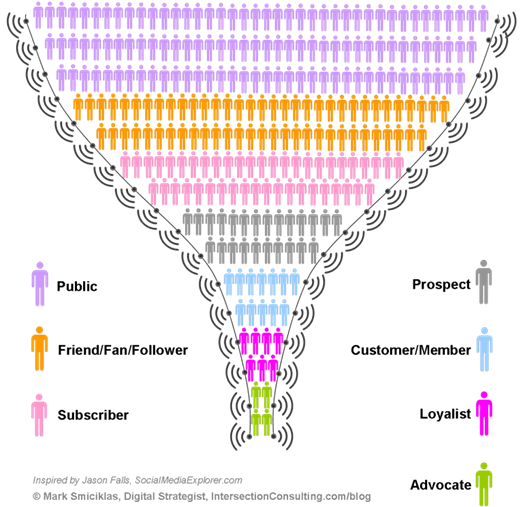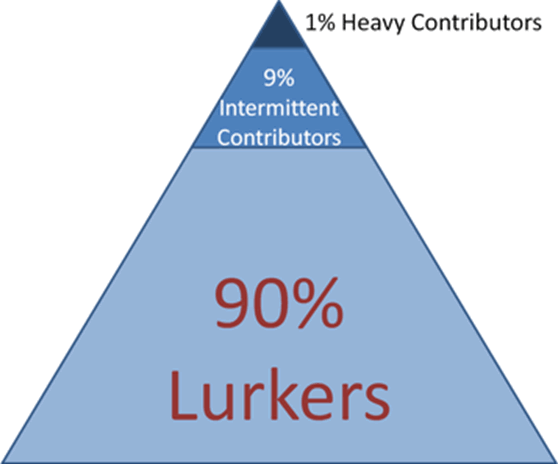
One of the main reasons people succeed with social media marketing where others fail is that they think of those with whom they’re communicating not as pixels on a screen but as real people with real needs, pains and interests and understanding the dynamics of online communities.
People are “communal” by nature as they can be engaged around their functions, disciplines, information needs and professions, to name a few. When we build relationships with people, whether it’s in a direct way (for instance, on a social network such as LinkedIn) or indirectly (for instance, the readers of our blogs), communities are built.
These communities already exist and need to grow. However, using social media, corporate blogs and dedicated community platforms you can identify them, provide them with home bases to interact and nurture them on social and the Web. The result is an online community. With the advent of social technologies, the number of possibilities to facilitate, nurture and engage online communities has exploded.
Online and social community marketing is about using the power of online communities to:
- Build personal relationships and networks of trust.
- Bring together people with common interests or profiles.
- Engage these specific groups of people.
Depending on the goals you want to serve and the target groups you want to engage, there are different types of online communities. The outcomes we strive for when engaging a community aim to fulfill several marketing and business objectives. Depending on these objectives, online communities will require more or less resources, dedication and value.
Types and behavior of online communities
Community is a natural phenomenon, a mindset and a way of engagement. It is also the essence of social business. Communities of people have always existed and online communities existed long before we even used blogs. Social communities are online communities using social platforms. They include personal communities and communities as they are built using tools such as LinkedIn or tailored customer and/or internal community platforms.
We all have online communities but some are less visible
An online community is no different than any other community except for the fact it’s online. It is a group of people with something in common, which could include shared interests, experiences, ideals, goals (typically in non-profit, for instance) or profiles (e.g. loyal customers or fans of a brand). Communities are often based on proximity. Every blog, business, blogger, organization and individual that is active on the Web has an online community and often even different ones.
These communities can partially overlap with offline communities. Your community of Twitter followers, for instance, can include friends, family members, colleagues and customers.
A big part of some communities is invisible. Take the community of blog readers, for instance. There is always a core community of loyal readers, fans of a specific blogger and people who are very interested in one topic and therefore keep coming back. But most will never comment so you can’t identify them. This is where forms, polls and mechanisms to capture data, for instance by offering an eBook, come in. Identification of community members, fans, etc. is essential in conversion.

On other social media it’s easier to identify the members of a community. Some are even built around people’s profiles and interests. There are several tools to bring together communities, depending on your goals, including tools to create a community outside popular social networks as you will learn further. However, here as well, the participation and visibility of the community will differ.
Participation inequality
In 2006, Web usability expert Jakob Nielsen introduced the 90-9-1 rule of user participation, when explaining the concept of participation inequality and how to encourage more users to contribute.
Although Nielsen’s rule wasn’t meant for online communities (alone), it applies to them.
The rule:
- 90% of users are lurkers: people who just read or observe but don’t contribute. These are typically the people that read but never comment.
- 9% of users contribute from time to time. They leave comments on blogs or participate actively in a community but it’s rather seldom.
- 1% of users participates a lot and account for most of the contributions. In social media, this is often the group where influencers and thought leaders can be found.

Levels of engagement and social technographics
Nielsen’s model has been used by many others as the basis for a typology of social media and community users. Forrester Research for instance identified inactives and spectators in its so-called Social Technographics Ladder (the exact numbers change over time and are general averages, they don’t apply to individual communities or networks).
Some people defined so-called pyramids of engagement, again showing the different degrees of participation.
What social and online communities are and are not
A LinkedIn Group is not an online community. Neither is a blog. They only become one if there are clear goals that are served by community engagement and if there is a clear community plan and management in place. In other words: it’s not about the platforms and tools; although the right choice and mix of community platforms is a question to answer when building and/or engaging communities.
It’s really important to realize that a community is about people and not about platforms in the first place. Members of a professional community that is built in LinkedIn also use other channels and media and they have an offline behavior too. The best communities take this multi-channel behavior into account.
The community classification and typology is done using different parameters:
- Scale: from your personal communities and communities of blog readers to larger online customer communities, member groups and branded communities.
- Scope: from exchanging thoughts and ideas, answering questions and answers to customer support and service, customer retention, etc.
- Settings: from members-only and private to public and visible.
- Maturity: from early-stage community features such as networking and content sharing to mature community features such as social collaboration and co-creation.
- Value proposition: from a proposition based on relevant content or simple networking to high-value member benefits.
- Members: from specific profiles and people interested in a similar topic to loyal customers or journalists.
- Tools: from cheap private network community platforms such as Ning and free ones such as LinkedIn to business-oriented corporate community platforms and self-owned and tailor-made communities.
In order to define what kind of communities you focus best on and what platforms to use, define your goals and analyze your target groups first.
The benefits of online communities for “members”
In order to “build” a structured community approach it’s key to understand what benefits they can offer to members, regardless of the form and shape the online or social community takes.
From customer support to content and information, the goals of your community marketing efforts, will depend on how you can match them with the resources you have, what you have to offer and what community members expect.
Check out some of the benefits communities can offer to community members.
Tapping the power of social community participation
Among the many reasons why communities fail is the “provide and pray” approach and a misunderstanding of mass collaboration, Gartner found.
In order to succeed and tap the power of social community participation, check out the six core principles the research firm came up with:
- Participation
- Collective
- Transparency
- Independence
- Persistence
- Emergency
Content, organization, scale and amplification are among the many activities in the framework. A more in-depth look here.
Next steps in this online and social community primer
Below is a non-exhaustive list of community-related topics in this primer. Some have been mentioned in the boxes above. More will be added soon!
- Social community basics: a strategy and a mindset
- Benefits of online and/or social communities for organizations
- Branded customer communities: what consumers expect
- Customer loyalty and communities: the full picture
- Why online communities are undervalued – and often fail
- Worker empowerment: 9 Cs of people-centric collaboration
- Social networks and organizations: on ecosystems and organisms
- Social business and social media marketing for managers

